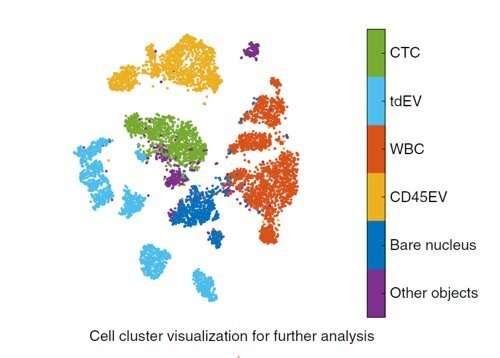Tracking tumor cells and unraveling hidden information

tumor cells circulating in the blood of cancer patients are important markers for early diagnosis, treatment success and patient prognosis. But since so few circulate, identifying them is a challenge. Thanks to artificial intelligence, researchers of the University of Twente managed to automate the process with a high level of accuracy. Additionally, the new technology not only detects the tumor cells, but also unravels hidden information. Extracellular vesicles, important in cell interaction, are classified, as well. The researchers presented their results in the February 10 issue of Nature Machine Intelligence.
Circulating tumor cells (CTCs) that are released from the original tumor and start moving in the blood stream play an important role in the onset of metastases in other parts of the body. Detecting them in patient's blood provides information about the effectiveness of treatment and the patient's prognoses. The number of CTCs is extremely small, so manually counting them using fluorescence microscopy is labor intensive, even for an expert that knows how to recognize CTCs. The new automated approach provides accuracy of over 96 percent.
UT scientists developed an open-source recognition package for the existing method that proved its clinical relevance; the new approach takes it to a higher level using automated learning. Advanced visualization yields even more information from a blood sample: CTCs of different types, as well as the extracellular CD45 vesicles that give extra information on cell collaboration, for example. Much research is currently being conducted on the role of these vesicles.
Window in black box
Researchers train deep-learning networks with a large set of well-labeled examples, after which they are able to learn and function by themselves, often better than humans do. How the actual learning process takes place and what choices the network makes internally are less transparent: A deep-learning network is essentially a black box. Thanks to the extra modeling and visualization step based on semi-supervised autoencoding, more information comes out of the network than expected. It is like you can see part of the learning through a small window in the black box. CTCs of different types, white blood cells and vesicles can be clearly distinguished.
The open-source image analysis program, ACCEPT, developed by Leonie Zeune, can be combined with the CellSearch technology for detecting CTCs. This technology, co-invented by Prof Leon Terstappen, is already being used by some hospitals. Thanks to the deep-learning development now presented, automated detection is further improved.
The paper, "Deep learning of circulating tumor cells," is published online in Nature Machine Intelligence.
More information: Leonie L. Zeune et al. Deep learning of circulating tumour cells, Nature Machine Intelligence (2020). DOI: 10.1038/s42256-020-0153-x




















